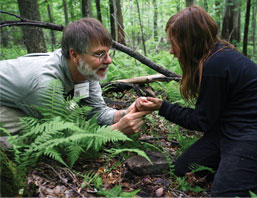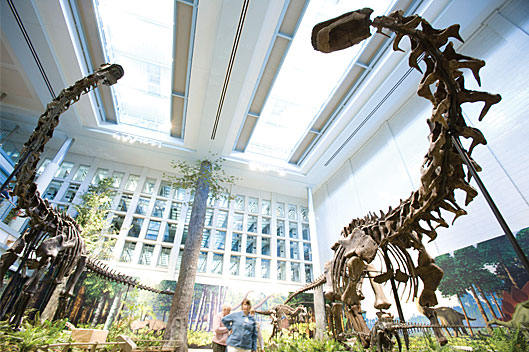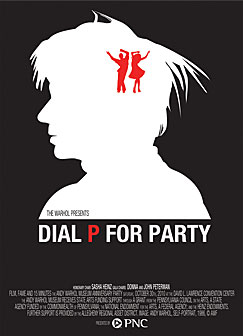|
|
 Operation conservation Operation conservation
When Tim Pearce, assistant curator of mollusks, joined Carnegie Museum of Natural History in 2002, the section had been without a permanent caretaker for 20 years. Since his arrival, use of the 100-year-old collection—numbering 1.8 million specimens of roughly 12,000 species—has increased tenfold.
Tim Pearce helps a student identify a land snail.
And now, with a recent $486,000 grant from the National Science Foundation, Pearce says he can conserve the irreplaceable specimens—think snails, slugs, oysters, mussels, and even octopi—and their corresponding data for generations to come, in the ballpark of the next 1,000 years.
The funding will allow Pearce, with the help of a new collection manager and trained volunteers, to tackle the crucial task of transferring the collection from its current acidic environment to an archival condition, complete with archival-quality specimen boxes and metal drawers.
Like all of the museum’s massive collections, the mollusks are tucked away from the curious eyes of museum-goers—minus the two-hour, behind-the-scenes tour offered to visitors each Saturday. But it’s a resource of international significance for researchers, as it includes the largest collection of northern Appalachian non-marine mollusks, one of the top five freshwater
mussel collections, and, overall, it’s the 15th largest mollusk collection in the country.
“A great deal of conservation work is based on museum collections,” says Pearce. “Through these dry specimens collected and preserved over centuries, we can tell what once was, and can infer what influences extinction.”
Living mollusks, he adds, serve a number of unique purposes. In addition to recycling nutrients, land snails and slugs are important food for other creatures, like chipmunks and fireflies, and are a crucial source of calcium for birds during egg-laying season. Freshwater mussels filter waste and impurities from rivers and lakes.
A leader in green construction

A longtime promoter of conservation science, Carnegie Museum of Natural History has earned a Silver Leadership in Energy and Environmental Design (LEED®) green building certification for its blockbuster Dinosaurs in Their Time exhibition.
The Pittsburgh Business Times listed Dinosaurs among the top seven largest LEED-certified projects in the city. Why is it so special? The building’s exterior walls were reused by closing in a service courtyard, retaining its exterior shell and offering efficient heating and cooling. Nearly all of the demolition and construction waste was recycled. And the museum installed simple technologies such as skylights and a white roof in the giant space to conserve energy and make the best use of natural resources.
Thanks to this effort, LEED certification is now the standard for major building projects across the four Carnegie Museums. Green and sustainable technologies have been used in two subsequent major projects: the renovation of the Florence Lockhart Nimick Education Center at Powdermill Nature Reserve, the Museum of Natural History’s biological field station, and the construction of Highmark SportsWorks® at Carnegie Science Center.
The LEED rating system is a third-party certification program and benchmark for designing, building, and operating green buildings. The highest or most green rating is Platinum followed by Gold, Silver, and Certified.
 Make a date with Andy. Make a date with Andy.
The Warhol’s 15 minutes has lasted 15 years. And like any hip teenager, it’s itching to celebrate—big and in style. Join The Warhol’s flashy 15th anniversary bash dubbed Film, Fame and 15 Minutes, presented by PNC Financial Services Group, on October 30 at the David L. Lawrence Convention Center. Save the date and keep an eye on your inbox for more details, or call 412.237.8300 for more information.
Robots rock!
 They think, feel, and act almost human. So why shouldn’t they rock out a little, too? In Rockin’ Robots: World Tour, students in schools throughout the region will get a lively look into the world of robotics through the exploits of Quasi, a lovable ‘bot who sets out on a figurative world tour in search of his place in the animatronic universe. It’s the latest in a growing list of Science on the Road in-school educational experiences devised by the creative staff at Carnegie Science Center. Partnering with the Science Center on Rockin’ Robots is California University of Pennsylvania, where college students interested in robotics study mechatronics, an interdisciplinary field that combines computer, electrical, and mechanical engineering in the creation of agile robots. They think, feel, and act almost human. So why shouldn’t they rock out a little, too? In Rockin’ Robots: World Tour, students in schools throughout the region will get a lively look into the world of robotics through the exploits of Quasi, a lovable ‘bot who sets out on a figurative world tour in search of his place in the animatronic universe. It’s the latest in a growing list of Science on the Road in-school educational experiences devised by the creative staff at Carnegie Science Center. Partnering with the Science Center on Rockin’ Robots is California University of Pennsylvania, where college students interested in robotics study mechatronics, an interdisciplinary field that combines computer, electrical, and mechanical engineering in the creation of agile robots.
 In Rockin’ Robots, debuting this fall, students will join Quasi, a creation of local robotics maker Interbots, in his Pinocchio-style quest to become a real robot. Along the way, students will have the chance to demo a working robot arm, and, thanks to on-screen visits by scientists and engineers, they’ll learn about hard-working robots around the globe: robots at work in factories, hospitals, and in exploration of land, sea, and space. By the end of his journey, Quasi gains the much-coveted robotic skills in thinking, sensing, and acting—and becomes a real rockin’ robot. “We talk about how robots are making our lives better, making our planet and our environment better, making our lives easier,” says Mike Hennessy, program development coordinator at Carnegie Science Center (see also FACE TIME). “We also look at how robots are really tools that can take us beyond our five senses and let us explore the universe in ways that, without these tools, we can’t.” In Rockin’ Robots, debuting this fall, students will join Quasi, a creation of local robotics maker Interbots, in his Pinocchio-style quest to become a real robot. Along the way, students will have the chance to demo a working robot arm, and, thanks to on-screen visits by scientists and engineers, they’ll learn about hard-working robots around the globe: robots at work in factories, hospitals, and in exploration of land, sea, and space. By the end of his journey, Quasi gains the much-coveted robotic skills in thinking, sensing, and acting—and becomes a real rockin’ robot. “We talk about how robots are making our lives better, making our planet and our environment better, making our lives easier,” says Mike Hennessy, program development coordinator at Carnegie Science Center (see also FACE TIME). “We also look at how robots are really tools that can take us beyond our five senses and let us explore the universe in ways that, without these tools, we can’t.”
 The viewer’s choice The viewer’s choice
Carnegie Museum of Art’s Two-Minute Film Festival drew a festive crowd of more than 200 people this past July, and was such a hit that the museum is hoping to make it a regular summertime event.
More than 80 filmmakers from 19 states submitted entries—two minutes in length or less—using the theme “A Brief History of …” as their prompt. A screening of the 38 selected films was held in the museum’s outdoor Sculpture Court, where attendees enjoyed cocktails and picnic food as part of the late-night Culture Club event.
Pittsburgh filmmakers Cecilia Beltrao, Matthias Grabmair, and Zumrut Imamoglu captured the People’s Choice vote and were awarded museum memberships for their film, A Brief History of Daily Transactions, which can be viewed on YouTube and features a brief Carnegie Museum of Art cameo.
Coming in second place was Wyoming by Jason Georgiades of Pittsburgh followed by A Brief History of The National Road by teacher Amanda Barber and her students from Hopwood, PA; On The Way to The Theatre, We Egged A Trans Am by Nathaniel Sullivan of Syracuse, NY; First Firing by Kelly Oliver and Keary Rosen of Raritan, NJ; and Fantastica by Bobbi Williams of Pittsburgh.
|
|
 Fall 2010
Fall 2010

 Operation conservation
Operation conservation
 Make a date with Andy.
Make a date with Andy. They think, feel, and act almost human. So why shouldn’t they rock out a little, too? In Rockin’ Robots: World Tour, students in schools throughout the region will get a lively look into the world of robotics through the exploits of Quasi, a lovable ‘bot who sets out on a figurative world tour in search of his place in the animatronic universe. It’s the latest in a growing list of Science on the Road in-school educational experiences devised by the creative staff at Carnegie Science Center. Partnering with the Science Center on Rockin’ Robots is California University of Pennsylvania, where college students interested in robotics study mechatronics, an interdisciplinary field that combines computer, electrical, and mechanical engineering in the creation of agile robots.
They think, feel, and act almost human. So why shouldn’t they rock out a little, too? In Rockin’ Robots: World Tour, students in schools throughout the region will get a lively look into the world of robotics through the exploits of Quasi, a lovable ‘bot who sets out on a figurative world tour in search of his place in the animatronic universe. It’s the latest in a growing list of Science on the Road in-school educational experiences devised by the creative staff at Carnegie Science Center. Partnering with the Science Center on Rockin’ Robots is California University of Pennsylvania, where college students interested in robotics study mechatronics, an interdisciplinary field that combines computer, electrical, and mechanical engineering in the creation of agile robots.  In Rockin’ Robots, debuting this fall, students will join Quasi, a creation of local robotics maker Interbots, in his Pinocchio-style quest to become a real robot. Along the way, students will have the chance to demo a working robot arm, and, thanks to on-screen visits by scientists and engineers, they’ll learn about hard-working robots around the globe: robots at work in factories, hospitals, and in exploration of land, sea, and space. By the end of his journey, Quasi gains the much-coveted robotic skills in thinking, sensing, and acting—and becomes a real rockin’ robot. “We talk about how robots are making our lives better, making our planet and our environment better, making our lives easier,” says Mike Hennessy, program development coordinator at Carnegie Science Center (see also FACE TIME). “We also look at how robots are really tools that can take us beyond our five senses and let us explore the universe in ways that, without these tools, we can’t.”
In Rockin’ Robots, debuting this fall, students will join Quasi, a creation of local robotics maker Interbots, in his Pinocchio-style quest to become a real robot. Along the way, students will have the chance to demo a working robot arm, and, thanks to on-screen visits by scientists and engineers, they’ll learn about hard-working robots around the globe: robots at work in factories, hospitals, and in exploration of land, sea, and space. By the end of his journey, Quasi gains the much-coveted robotic skills in thinking, sensing, and acting—and becomes a real rockin’ robot. “We talk about how robots are making our lives better, making our planet and our environment better, making our lives easier,” says Mike Hennessy, program development coordinator at Carnegie Science Center (see also FACE TIME). “We also look at how robots are really tools that can take us beyond our five senses and let us explore the universe in ways that, without these tools, we can’t.” The viewer’s choice
The viewer’s choice